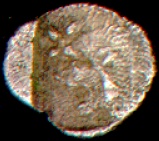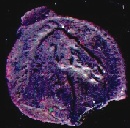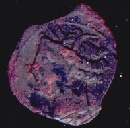Brad's Introduction to Ancient Coins
 Now let me give you an informal introduction into the history of
ancient coins. Coins were first made in the seventh century BC,
in the Greek world. At first there was a design on only one side,
usually showing an animal. The other side had a punch mark
from the production of the coin. The development of coinage
allowed people to know that they were receiving a
standard amount of metal in exchange for their goods.
As with all coins made during
the next 2300 years or so, each coin was produced by hand.
In ancient times, this was usually done by placing a piece of
metal between two dies, and striking with a hammer.
The dies would last for tens of thousands of coins.
Ancient coins were numerous and in general are not rare at all.
Millions were produced each year, and many billions in the ancient era.
Now let me give you an informal introduction into the history of
ancient coins. Coins were first made in the seventh century BC,
in the Greek world. At first there was a design on only one side,
usually showing an animal. The other side had a punch mark
from the production of the coin. The development of coinage
allowed people to know that they were receiving a
standard amount of metal in exchange for their goods.
As with all coins made during
the next 2300 years or so, each coin was produced by hand.
In ancient times, this was usually done by placing a piece of
metal between two dies, and striking with a hammer.
The dies would last for tens of thousands of coins.
Ancient coins were numerous and in general are not rare at all.
Millions were produced each year, and many billions in the ancient era.

 Within a couple hundred years, coins had designs on both sides.
By the fourth century BC, the artwork on some coins was magnificient --
perhaps its highest level at any time in history. Scanning coins,
especially those made with bronze, can be difficult, and the images
on these pages do not do the coins justice.
Within a couple hundred years, coins had designs on both sides.
By the fourth century BC, the artwork on some coins was magnificient --
perhaps its highest level at any time in history. Scanning coins,
especially those made with bronze, can be difficult, and the images
on these pages do not do the coins justice.
Coins also began to be used outside the Greek domain, in Persia,
for example, and bronze (or similar copper alloys) coins appeared
in addition to the silver and rarer gold coins. Coins also
began to include inscriptions, usually indicating the city
the coin was minted in.
As the Romans became the dominant force in the Mediterranean,
their coins were produced in greater numbers and with a
wide variety of designs. When the Roman Republic evolved
into the Roman Empire in the late first century BC, their
coins began depicting the Emperor on the obverse, and
including their name and copious titles in the inscription.
The reverses often show gods or personifications of colonies
that had been captured.
As the Roman Empire declined, so did the quality of the
artwork on their coins. By the fall of Rome in the late
fifth century AD, the coins became smaller and almost cartoonish.
This is normally thought of as the endpoint for ancient coins.
Continue to More About Ancient Roman Coins.
Send e-mail to me at
 .
.
Last updated January 25, 2024.
 Now let me give you an informal introduction into the history of
ancient coins. Coins were first made in the seventh century BC,
in the Greek world. At first there was a design on only one side,
usually showing an animal. The other side had a punch mark
from the production of the coin. The development of coinage
allowed people to know that they were receiving a
standard amount of metal in exchange for their goods.
As with all coins made during
the next 2300 years or so, each coin was produced by hand.
In ancient times, this was usually done by placing a piece of
metal between two dies, and striking with a hammer.
The dies would last for tens of thousands of coins.
Ancient coins were numerous and in general are not rare at all.
Millions were produced each year, and many billions in the ancient era.
Now let me give you an informal introduction into the history of
ancient coins. Coins were first made in the seventh century BC,
in the Greek world. At first there was a design on only one side,
usually showing an animal. The other side had a punch mark
from the production of the coin. The development of coinage
allowed people to know that they were receiving a
standard amount of metal in exchange for their goods.
As with all coins made during
the next 2300 years or so, each coin was produced by hand.
In ancient times, this was usually done by placing a piece of
metal between two dies, and striking with a hammer.
The dies would last for tens of thousands of coins.
Ancient coins were numerous and in general are not rare at all.
Millions were produced each year, and many billions in the ancient era.

 Within a couple hundred years, coins had designs on both sides.
By the fourth century BC, the artwork on some coins was magnificient --
perhaps its highest level at any time in history. Scanning coins,
especially those made with bronze, can be difficult, and the images
on these pages do not do the coins justice.
Within a couple hundred years, coins had designs on both sides.
By the fourth century BC, the artwork on some coins was magnificient --
perhaps its highest level at any time in history. Scanning coins,
especially those made with bronze, can be difficult, and the images
on these pages do not do the coins justice.
 .
.